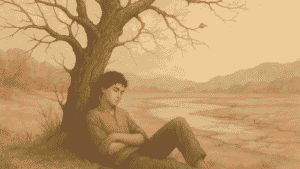A powerful poem about conflict, exploring the psychological and societal impact of violence, told through haunting imagery, rhyme, and literary depth.
About the Poem:
“The Ink of Violence” is a lyrical exploration of how violence seeps into the human psyche, society, and speech. Through vivid metaphor, rich rhyme, and classical diction, the poem paints violence not only as a physical force but as a cultural ink that stains thought, language, and morality. Each stanza reflects a descent — from societal corruption to personal fear — illustrating how conflict, once spoken into existence, embeds itself into our shared human condition.
The Ink of Violence
A sable shroud begins to spread,
It crowns the sky, it strikes the head.
It coils through thought like whispered sin,
And plants a war in hearts within.
It thrives where kindness dares to tread,
It drinks from fear, and feasts on dread.
Each honeyed lie, each sharpened jest,
Becomes a blade in virtue’s chest.
They crown the thief, they praise the gun,
They hide the crime when deeds are done.
They bury blame in foreign ground,
Then preach with voices safe and sound.
Barefoot I walk through briars deep,
The thorns like secrets no one keeps.
My flesh is fire, my soul is tense,
Burning in violence, past all sense.
Poem Analysis & Interpretation: The Ink of Violence – A Poem About Conflict
Theme Overview:
“The Ink of Violence” explores how violence infiltrates society, language, and the human psyche. It is not limited to physical conflict but manifests in the corruption of morality, the distortion of truth, and the normalization of cruelty. The poem critiques how people justify violence, hide behind false virtue, and remain blind to the internal consequences of their actions. The poet also portrays violence as a generational and cultural stain — something written into the very fabric of our existence like “ink.”
Primary Themes:
-
Psychological and emotional impact of violence
-
The moral decay of society and leadership
-
Hypocrisy and complicity in social injustice
-
Internalization of fear and trauma
-
The symbolic power of language and silence
Stanza-by-Stanza Breakdown:
Stanza 1:
A sable shroud begins to spread…
This stanza introduces violence as a creeping darkness — a “sable shroud” (black cloth of mourning). The image is metaphorical, showing how violence obscures reason and overtakes society like an unstoppable force. The rhyme and rhythm emphasize inevitability. The phrase “plants a war in hearts within” shows how conflict begins internally, in the space of thought and belief.
Stanza 2:
It thrives where kindness dares to tread…
Here, the poem shows violence as an entity that is hostile to goodness. It “feeds on fear” and turns words into weapons. The “honeyed lie” and “sharpened jest” symbolize how seemingly soft or clever language can become violent when corrupted. The “blade in virtue’s chest” is a powerful image of betrayal and the destruction of innocence.
Stanza 3:
They crown the thief, they praise the gun…
This stanza shifts from metaphor to societal critique. It describes how power structures glorify violence and criminality. “Crown the thief” suggests that corrupt leaders are celebrated, while “bury blame in foreign ground” points to scapegoating and denial. There’s a strong condemnation of moral cowardice and hypocrisy here.
Stanza 4:
Barefoot I walk through briars deep…
The final stanza personalizes the poem’s message. The speaker now experiences violence directly, symbolized by walking barefoot through thorns — pain that’s intimate and constant. “My flesh is fire” and “my soul is tense” highlight the internal tension and trauma violence leaves behind. The last line “burning in violence, past all sense” expresses despair, numbness, and the erosion of rational thought due to relentless conflict.
Key Symbols & Their Meaning:
| Symbol | Meaning |
|---|---|
| Sable shroud | Darkness, mourning, the overwhelming spread of violence. |
| Ink | Language, speech, and ideology used to justify or spread violence. |
| Honeyed lie | Deceptive words that seem sweet but carry harm. |
| Blade in virtue’s chest | The betrayal and destruction of morality and innocence. |
| Gun in foreign ground | Displacement of guilt; blaming others for one’s violence. |
| Barefoot walk through briars | Vulnerability, pain, and personal exposure to a hostile world. |
| Fire in flesh / tense soul | Emotional trauma, anxiety, and psychological damage. |
Message of the Poem:
The poem’s core message is that violence is not just an act — it is a cultural condition, spread through language, sanctioned by society, and internalized by individuals. It begins in words, flourishes in fear, and ultimately distorts both collective morality and personal identity.
Rather than simply condemning physical aggression, the poem interrogates how ideas, rhetoric, and silence can all become complicit in creating a violent world. The final stanzas reveal that the speaker is not just observing violence but is emotionally and physically consumed by it — a warning about what happens when we accept violence as normal.
This makes “The Ink of Violence” a powerful modern poetic commentary on contemporary conflict, systemic injustice, and personal trauma.
Glossary:
| Word/Phrase | Meaning |
|---|---|
| Sable | A poetic word for black or dark, often symbolizing mourning. |
| Shroud | A cloth used to cover a body; metaphor for a veil or covering of darkness. |
| Incarnate (earlier draft) | In the flesh; personified or made real. |
| Coils | Twists or winds, often suggesting something sneaky or sinister. |
| Honeyed lie | A sweet-sounding but deceptive falsehood. |
| Sharpened jest | A joke with cruel or cutting intent. |
| Virtue | Moral excellence or goodness. |
| Briars | Thorny shrubs or plants, often symbolizing hardship. |
| Feasts on dread | Gains strength from fear. |
| Kindled (earlier draft) | Set aflame; metaphor for emotional intensity or trauma. |
In My Dream – A Beautiful Dreamscape Poem with Explanation


